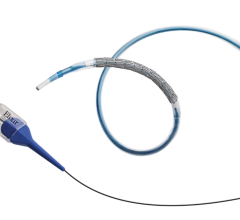
Photo courtesy of Cordis
The drug-eluting stent (DES) market is a multibillion dollar business in the U.S. — and it's estimated that over three million people have received DES worldwide since their approval, representing over 4.5 million DES implantations.
Today, there are two DES devices on the market: Cypher by Cordis, a Johnson & Johnson company, and Taxus by Boston Scientific. These devices have revolutionized the way people live with coronary artery disease.
However, there has been some speculation that DES might be linked to some serious adverse events. As early as six months following the approval of the Cypher stent, the FDA identified 50 hypersensitivity cases in people who had received it.
Recently, more and more people are debating whether first-generation DES technologies are as safe and effective as they were once portrayed to be, such as in the days of clinical trials RAVEL and SIRIUS.
In the pre-DES era, restenosis rates were high, ranging from 20 to 30 percent. Nevertheless, the advantages of undergoing a PCI in most cases far exceeded the alternative. The advent of the stent made the decision easy for many — getting a stent versus going under the knife.
Once DES were finally approved in the U.S. and more complicated cases were attempted, it made sense to opt for elective PCI over surgery. Furthermore, early DES results were very promising: The RAVEL study reported a zero percent restenosis rate, and SIRIUS restenosis results were in the single digits. The issue of safety seemed to be eschewed because of the better outcomes: less restenosis meant fewer repeat procedures, which led to cost savings for both hospitals and patients.
Did Hospitals get too Comfortable?
What changed in the stenting era? More and more hospitals began to offer angioplasty services. Technological advances such as DES brought smaller, stronger and better stents to the market. Education, direct-to-consumer advertising and the Internet helped to inform patients about their options. They began asking their doctors for drug-eluting stents by name and were being placed on waiting lists to receive them even before being approved as candidates. Pressure on the healthcare system to reduce costs and hospitals' need to maintain profitability was, and remains, a significant driver for DES today.
Morgan Stanley analysts indicated that in 2004 over one million angioplasties were performed in the U.S., of which approximately 80 to 90 percent included a stent. Morgan Stanley predicted that the percentage of patients undergoing PCI who would receive a stent would exceed 90 percent in 2005.
This life-saving technology has spared hundreds of thousands of lives since its approval by greatly reducing restenosis. A year ago, Boston Scientific celebrated its “millionth” Taxus stent implantation.
According to an article published on www.angioplasty.org, DES are “clearly the most important recent advance in the field of coronary angioplasty.”
And Martin B. Leon, M.D., renowned interventional cardiologist at New York-Presbyterian/Columbia University Medical Center, has commented on DES advantages, too.
“Stents have narrowed the gap in mortality benefit in CABG versus PCI,” he said. “Drug-eluting stents, now with more data coming, should erase the differences.”
And in many cases, DES have erased this difference by allowing patients, who may have once been subjected to bypass surgery, to opt for the alternative, less invasive approach. However, safety issues still loom and have been hotly debated, at least in the past year.
So What's the Problem with a One-Percent Adverse Event Rate?
The problem is severe adverse events can result in death. In January 2006, results from a study published in the Journal of the American College of Cardiology (ACC) by investigators at Northwestern Memorial Hospital (Chicago) reported “hypersensitivity-link” symptoms in patients who had received DES. The most troubling adverse event was four deaths that the investigators believed were directly related to the DES' polymer coating. The investigators of the DES RADAR Project believed that the polymer (plastic diffusion barrier) used to coat the stent was most likely the culprit. In certain situations, the polymer coating has caused serious events, such as abrupt stent closure (usually the result of stent thrombosis) and death, states the Northwestern paper.
There are unknown factors surrounding surface-coating stents that may not be tolerable in some patients and for some conditions.
“Polymer coating is a good way to carry and control the release of anti-restenotic drugs, [however] current DES have 1,000 mcg or more of polymer that remains in the artery,” said Donald S. Baim, M.D., interventional cardiologist at Boston's Brigham and Women's Hospital and professor of Medicine at Harvard Medical School.
But how much of it is truly the fault of the device itself? In other words, how much does operator misjudgment and/or even patient characteristics contribute to the problem? Dr. Baim says that “stent mal-apposition to the vessel wall… can create [an environment] for stent thrombosis.” He indicates that incomplete stent expansion, complex coronary procedures and the way patients respond to certain drugs also can contribute to adverse outcomes.
Stent thrombosis remains a devastating problem affecting 0.5 to 1.9 percent of bare-metal stent recipients and 0.5 to 2.0 percent of DES recipients. Alarmingly, in a pooled analysis of multicenter data of nearly 6,200 patients, stent thrombosis caused nearly seven and nine percent of patient deaths at 30 days and six months, respectively, following DES placement when compared to a one- percent death rate at six months in patients experiencing no stent thrombosis, according to a paper published by Jeffrey J. Popma, M.D., FACC, director, Interventional Cardiology and associate professor of Medicine at Harvard Medical School.
The Safety Concern
There is evidence to support the thrombogenecity of DES. As more complex cases are performed and longer stents are used, the stent thrombosis problem is likely to be more prevalent.
Is one DES more thrombogenetic than the other?
The short answer is no. Although the DES manufacturers will try to sway audiences one way or another by showing that their DES is slightly less thrombogenetic than that of their competitors, in reality both the Cypher and the Taxus are relatively equal in terms of thrombogenecity. In the SIRTAX trial, the results were insignificant in terms of stent thrombogenecity.
Renu Virmani, M.D., FACC, medical director at CVPath, shared her thoughts on the safety of DES at the 2005 Drug Eluting Stent Revolution IV symposium. She believes that two DES components — the drug and the polymer — might be the culprits of stent thrombosis. She also indicated that as usage increases and as longer stents are placed, the incidence of stent thrombosis would continue to increase.
The Northwestern investigators indicated that stent thrombosis is less likely to be caused by the drug itself, but rather by the polymer. Dr. Virmani noted that some of the most likely causes of stent thrombosis would occur as a result of polymer cracking, peeling or webbing. She also suggested that the polymers currently used on DES are proinflammatory. However, she indicated that inappropriate use of DES and premature withdrawal of anticoagulant could also lead to stent thrombosis.
Are DES Destined to Fail?
This question was put forward by Dr. Virmani at last year's ACC meeting. Many physician experts agree that there is at least some sort of link between stent thrombosis and polymer, as discussed at ACC and TCT 2005. It was also the subject of Laura Mauri’s (M.D., Brigham & Women’s Hospital) segment of an NACCME Webcast in January.
Nevertheless, it is unlikely that physicians will stop using the device altogether. But it is important to consider the alternatives.
One option is life-long antiplatelet therapy. Many experts believe that patients who receive DES are at higher risk of stent thrombosis and delayed vessel healing and would require antiplatelet therapy for at least one year and possibly forever. This was also echoed in Dr. Mauri’s Webcast discussion.
But most patients with coronary heart disease are also likely to suffer from other medical conditions that require other medications, as well. In these cases, the likelihood of medication noncompliance greatly increases.
Furthermore, studies have shown that prolonged use of oral antiplatelet agents can cause serious side effects, including those caused by drug-to-drug interaction. Studies also suggest that prolonged use of clopidogrel can lead to patients building a resistance to the drug.
Long-term use of clopidogrel can be expensive as well. In the U.S. it can cost over $14,000 a year. Even though clopidogrel can prevent adverse cardiovascular events from recurring, it may also inhibit the clotting process. This is important, particularly for patients who undergo surgical procedures.
Back to Bare?
Another option is going back to the basics, which would mean returning to the use of bare metal stents. Although this is unlikely, given the usage trends of DES, some experts believe that some bare metal stents are better than first-generation DES technology. Some of these physicians also believe that getting back to the basics might reduce the need for prolonged antiplatelet therapy.
New alloys, such as cobalt-chromium, may be the solution. For example, an insignificant difference in stent thrombosis rates was observed between the Endeavor stent and the Driver stents during the Endeavor II trial at 30-day and nine-month follow-ups. Furthermore, bare metal stents cost less. According to a survey, cath lab managers indicated their willingness to pay a premium for stents, such as a cobalt alloy stent, that could be a viable alternative to DES, as long as the stent is supported by favorable clinical results and if it offered usability advantages over previous technologies.
Yet, with widespread acceptance and a growing clinical dependence on DES, the likelihood of weaning physicians off DES is highly unlikely. Therefore, something needs to be done to ensure the safety and efficacy of future DES devices.
The next series of DES that are expected to enter the market are: Endeavor, Zomaxx and Xience by Guidant, which are much the same in terms of the way stents are currently coated and loaded. These second-generation stents are different because of the stent material used (e.g., cobalt-alloys). However, they still remain circumferentially coated, meaning that every surface of the stent is covered with drug and polymer.
Next issue: We continue this exploration of drug-eluting stents and the coming advances that may combat the occurrence of thrombosis.




 July 02, 2024
July 02, 2024 









